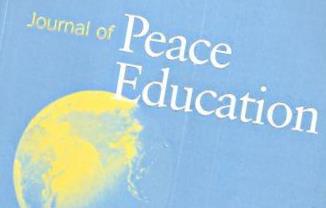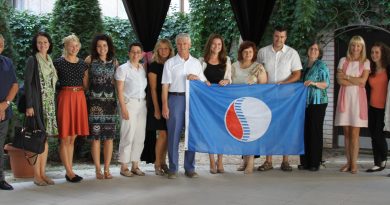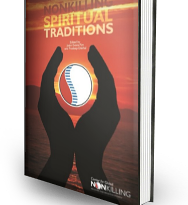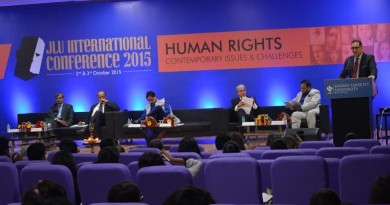Journal of Peace Education Special Issue on Nonkilling
The Journal of Peace Education, published by Taylor & Francis under the sponsorship of the Peace Education Commission of the International Peace Research Association and edited by Jeannie Lum, has just released the contents of its special issue [15(3)] on NONKILLING EDUCATION and in tribute of CGNK founder Prof. Glenn D. Paige. The special issue was made possible by the contributions of authors from CGNK’s Nonkilling Research Committees and the support of JPE Editor Jeannie Lum. Articles included in the special issue are available from the Journal’s website:
- Preface, by Jeannie Lum
- Nonkilling 101 — Is a Nonkilling Society Possible?, by Joám Evans Pim (see full text below)
- Teacher Glenn: how a political scientist educated a peace researcher, by Chaiwat Satha-Anand
- One anthropologist’s answer to Glenn D. Paige’s question challenging peace studies, by Leslie E. Sponsel
- Education for nonkilling creativity: a reconstructive–empowering approach, by Sofía Herrero Rico
- Preventing violence through hip hop: an evolutionary perspective, by Joám Evans Pim
- Not unlearning to care – positive moral development as a cornerstone of nonkilling, by Eveline Gutzwiller-Helfenfinger
- Building peace through education, by Shelley Hymel & Lina Darwich
An introduction to the special issue was prepared by CGNK Director Joám Evans Pim, who was involved as Guest Editor, and is reproduced below.
Nonkilling 101 — Is a Nonkilling Society Possible?
by Joám Evans Pim
“Not words of routine this song of mine, But abruptly to question, to leap beyond yet nearer bring”— “Song of Myself”, Walt Whitman, 1959
Glenn D. Paige (1929-2017) was, first and mostly, a teacher. Wherever he was, everybody around him would likely be introduced to the concept and challenge of a nonkilling society, a society “characterized by no killing of humans and no threats to kill; no weapons designed to kill humans and no justifications for using them; and no conditions of society dependent upon threat or use of killing force for maintenance or change (Paige [2002] 2009, 21). To do this he would use of number of pedagogical devices, including what would become the logo of the Center for Global Nonkilling, that seeks to illustrate how “creative transformational initiatives (blue), drawing upon nonkilling human capabilities (white), work to end human killing (red)”.
But the most revealing of such devices were simple but far-reaching questions, such as the ones that both open and close his seminal book Nonkilling Global Political Science (2002): “Is a nonkilling society possible? If not, why not? If yes, why?” The writing of Paige’s book was in fact a result of repeatedly and systematically posing these questions again and again for almost two decades to diverse audiences from around the world (see Paige, 1993, 1996), and analysing and exploring the equally diverse and often unexpected answers received. Chapter 1 of the book explores some of these answers, from the often anticipated “It’s absolutely unthinkable!” to “It’s completely possible”. Every year, teaching my own courses on nonkilling and introduction to peace studies, I start off the first session following Paige’s pedagogy by asking students these same questions, taking a vote and noting ‘ayes’ and ‘nays’ on the board. The results vary from year to year but are often balanced. Following the vote, participants are asked to report the main reasons that justify their position, and a lively discussion follows going straight to the bone to some of the most problematic issues that haunt those concerned with ending human lethality, from homicide to war.
Year after year the same set of arguments in favour and against is usually raised. The nays frequently refer to the innately violent human nature, greed, our history of lethality or psychopathic tendencies. The ayes often emphasize the human potential for change, the possibility for more equitable distribution of resources and the catalytic role of education. Nonkilling Global Political Science in fact starts off with an analysis of both perspectives and provides a wealth of multidisciplinary arguments that support an affirmative answer. In spite of its title, the book has been used to teach graduate and undergraduate courses of disciplines far away from the field of political science. Translations to more than 30 languages have been published around the world. And explorations of the same questions from many other disciplines (including anthropology, arts, geography, future studies, history, linguistics, media studies, neuroscience, psychology, physics, mathematics, engineering, security, sociology, and education) have expanded over the past decade, including conferences, seminars, panels and collective volumes (see Adolf 2010, Christie and Evans Pim 2012, Dator and Evans Pim 2012, Evans Pim 2009; 2010; 2011; 2013a; 2013b, Evans Pim and Dhakal 2015, Evans Pim and Herrero Rico 2017, Friedrich 2012, Tyner and Inwood 2011).
Having served at Seoul National University, Princeton and Hawai’i, Paige was a university teacher, but fully grasped the importance of introducing nonkilling education at all levels. For years he supported a grass-roots primary school in Kazimia, DR Congo, that promoted a unique curriculum based on the idea of nonkilling in the midst of continuing civil war and insurgencies. The school is today called the “Glenn Paige Nonkilling School” and continues serving its founding purpose with little outside attention or support. Every year students are invited to reflect around the violence that surrounds them through the same questions that open Nonkilling Global Political Science—the same organization running the school developed an abridged Kiswahili version Ujenzi wa Jamii Isiyokuwa na Mauaji which has been used extensively in seminars focused on diverse adult audiences. Paige ([2002] 2009, 78, 81-82) believed that “an educational and training revolution” was necessary “to provide knowledge and skills for nonkilling transformation”. Instead of “reflecting and affirming lethal traditions and conditions” nonkilling education should be a significant contributor to nonkilling global change. A nonkilling curriculum should include “the knowledge requirements of nonkilling analysis, the need for applied skills to transform propensities to kill into nonkilling alternatives, and the need to perfect principles to guide individual and social action”. Thinking of political science students, and based on his many years of experience teaching nonviolence at the University of Hawaii, Paige proposed what a ‘101’ introductory course on nonkilling would look like:
After vivid introduction to the horrifying history of lethality and the inspiring legacy of nonkilling creativity, the curriculum presents the logic of nonkilling political analysis and challenges engagement in discovery of principles and processes for effective problem-solving action. Participants review the causes of killing, nonkilling, transitions, and hypotheses about the characteristics of nonkilling societies. From this perspective, historical developments of political institutions and processes, locally and globally, are examined. Problem-solving challenges are posed—such as homicide, democide, genocide, and disarmament; economic lethality; human rights atrocities; ecological biocide; and destructive divisiveness versus cooperation across diversity. Opportunities to develop skills in modes of problem solving engagement are offered: research, teaching, servant leadership, and critical communication. On these foundations individual and group projects to solve problems and develop skills are pursued and presented ([2002] 2009, 82).
Paige believed that exposing individuals to the question “Is a nonkilling society possible?” was an eye-opener that was instrumental in raising awareness of unnoticed realities—of killing but also nonkilling realities often overlooked. The question was an initial step of a “Process of Normative-Empirical Nonkilling Paradigm Shift” ([2002] 2009, 78-79) from “from nonkilling societies are impossible, to nonkilling societies are problematical, to actual and hypothetical exploration of characteristics of nonkilling societies, to scientific commitment to seek knowledge to create and sustain nonkilling societies in a nonkilling world”. Without posing the initial question we comfortably remain within the realm of the predominant lethality-accepting worldview, powerless to imagine alternatives and bring about change. The self-perpetuating assumption drag is broken when we open our mind to explore the problem posed by the question, even if answers remain negative—as often is the case with students taking my own courses. That is why, throughout his life, Paige set out in a mission to expose people to this question and come up with their own unique answers and reasoning.
Having founded the Center for Global Nonkilling, throughout the years this organization also placed great efforts in bringing the question “Is a nonkilling society possible?” to classrooms and training programs around the world. In 2009, 2010 and 2011 annual Global Nonkilling Leadership Academies were organized in Hawai’i including participants from Canada, China, Colombia, Germany, Guatemala, Haiti, India, Iran, Ireland, Israel, Italy, Kenya, Liberia, Nepal, Palestine, Philippines, Rwanda, Thailand, Trinidad, the United States and Western Sahara. Nonkilling has also been featured in graduate or undergraduate courses at the University of Hawai’i, Creighton University, Augusta State University, Ohio State University, the University of Wisconsin, and the University of Alabama at Birmingham, in the United States of America; Thammasat University, in Thailand; Åbo Akademi University and Tampere University, in Finland; Jagran Lakecity University and the University of Kerala, in India; the University of Chittagong, in Bangladesh; Canadian Mennonite University, in Canada; Jaume I University, in Spain; and the University of the Philippines, to mention just a few examples. The personal experience of Professor Leslie Sponsel and Professor Chaiwat Satha-Anand, teaching nonkilling to their own students, is reflected upon in this special issue.
The question was also brought to a diversity of scientific gatherings, including panels on Nonkilling Global Political Science at the European Consortium of Political Research (Budapest, 2005) and the International Political Science Association (Santiago de Chile, 2009), the Nonkilling Neuroscience Exploratory Colloquium (Philadelphia, 2009), the Interdisciplinary Seminar on Nonkilling Research at the University of Hawai’i (2009 and 2010), the Nonkilling Societies Exploratory Colloquium (Montréal, 2011), the The Bio-Social Bases for Nonkilling and Nonviolent Behavior Workshop (Leiden, The Netherlands, 2014) or the Nonkilling Balkans Forum (Sarajevo, 2014)—to mention some of those organized by the Center for Global Nonkilling. It was also brought to an international conference organized at Åbo Akademi University, Vasa, Finland, in March 2015, with the particular focus on “Nonkilling Education”. This special issue originates in some of the important issues raised at that exploration, including: (a) Poor education as a causal factor of killing and violent behavior; (b) The educational consequences of violent environments and potential benefits of moving toward killing free societies (with no killing, threats to kill or conditions conducive to killing), and (c) The educational measures and transformations relevant to building societies where human killing is greatly reduced and eventually absent. Discussion topics raised beforehand by the Nonkilling Education Research Committee included:
- The educational aspects of transition to a killing-free society
- What can we learn from peaceful societies, namely simple hunter-gatherers, in terms of parenting, early childhood development and educational practices?
- Can we deconstruct the different types of violence (direct, structural, cultural) that are reproduced in educational institutions as social subsystems and reconstruct peaceful/nonkilling educational paradigms?
- How to bridge the nonkilling approach with environmental education, ecojustice education, human rights education and indigenous-inspired education? How does this relate to extending nonkilling principles to respectful treatment of nonhuman animals and other forms of life?
- How does nonkilling education relate to strategies to decrease bullying and intolerance among school children to bring about discrimination and prejudice-free society are effective?
- What educational methods for teaching ethnically and religiously mixed classes in order to create culturally inclusive classroom environment are effective?
- Peaceful and dialogic-participative teaching methodology.
- Needed changes in undergraduate and graduate teacher training, textbooks, and research.
During the conference, participants highlighted the need to refocus child-rearing practices in the zero-to-six period with an understanding of its importance for bringing up healthy nonkilling individuals (evidence on importance of prolonged breast-feeding, cuddling, extensive alloparenting, etc.). Small schools embedded within small communities with active teachers-family interaction and involvement, were also signalled out as an appropriate educational environment for building killing-free communities. Where applicable, multicultural environments should be used as a resource for cooperative learning and not as a problem.
Other changes suggested in the discussions included the need to shift from competitive/individualistic education and play to cooperative and experiential approaches that enable social-emotional competences and active critical thinking. Authority and obedience as relational principles at school, families and communities needed to shift toward a common ethic of care, compassion and kindness, incorporating restorative (vs. punitive), peer mediation and other approaches to problem-solving. Recognition of the other as well as imagination and creativity in seeking nonkilling alternatives for peaceful conflict transformation are key aspects. Violent role-models, especially in the media and entertainment, which also need to be minimized countering them with the inclusion of nonviolence and conflict prevention/management as overarching social competences.
A first tangible result of the conference was made public shortly after under the title “Vasa Statement on Education for Killing-Free Societies”. The statement contains a set of recommendations drafted by the graduate students of Åbo Akademi University’s Programme in Peace, Mediation and Conflict Research, incorporating notes from the conference and participant’s feedback as well as references providing additional information for each item in an appendix. The document, available in English, French and Spanish, was later on submitted as a formal written statement to the United Nations Secretary General addressing the 30th session of the Human Rights Council (Geneva, September 14-October 2, 2015) under UN Documents reference number A/HRC/30/NGO/15, receiving wide attention. A second tangible result was a collective volume published in 2017, Nonkilling Education, that joins other disciplinary approaches published by the Center for Global Nonkilling in its series. This special issue of the Journal of Peace Education is a third unique contribution of that conference but also wishes to commemorate the life and work of Glenn D. Paige and his invitation to scholars, practitioners and learners of all levels and types of education to envision how we can contribute to societies that do not kill.
Days before the conference on “Nonkilling Education” was celebrated in Vasa, the United Nations General Assembly passed Resolution A/RES/70/1 of 25 September 2015 adopting the Sustainable Development Goals (SDGs). SDG target 16.1 explicitly called the global community to “significantly reduce all forms of violence and related death rates everywhere” by 2030, thus embracing the principle of nonkilling by making it a global goal for all. Acknowledging the interdependence between SDG targets, special mention must be made to the relation between target 16.1 and target 4.7, in which the global community also commits to “ensure that all learners acquire the knowledge and skills needed to promote sustainable development, including, among others, through education for sustainable development and sustainable lifestyles, human rights, gender equality, promotion of a culture of peace and nonviolence, global citizenship and appreciation of cultural diversity and of culture’s contribution to sustainable development”, while also emphasizing the importance of building and upgrading education facilities that provide “safe, nonviolent, inclusive and effective learning environments for all” (4.a). Just as public health and criminology scholars and practitioners convened in 2014 to explore “Global Strategies to Reduce Violence by 50% in the Next 30 Years” in a World Health Organization sponsored conference at the University of Cambridge (Eisner 2015, Krisch et al. 2015) it is hoped that this special issue invites further explorations on how education can contribute to similar and even bolder targets. It all starts with a simple but far-reaching question.
References
- Adolf, Antony, ed. 2010. Nonkilling History: Shaping Policy with Lessons from the Past. Honolulu: Center for Global Nonkilling.
- Christie, Daniel J. and Joám Evans Pim, eds. 2012. Nonkilling Psychology. Honolulu: Center for Global Nonkilling.
- Dator, James A. and Joám Evans Pim, eds. 2012. Nonkilling Futures: Visions. Honolulu: Center for Global Nonkilling.
- Eisner, Manuel. 2015. How to Reduce Homicide by 50% in the Next 30 Years. Rio de Janeiro: Igarapé Institute.
- Evans Pim, Joám and Pradeep Dhakal, eds. 2015. Nonkilling Spiritual Traditions. Honolulu: Center for Global Nonkilling.
- Evans Pim, Joám and Sofía Herrero Rico, eds. 2017. Nonkilling Education. Honolulu: Center for Global Nonkilling.
- Evans Pim, Joám, ed. 2009. Toward a Nonkilling Paradigm. Honolulu: Center for Global Nonkilling.
- Evans Pim, Joám, ed. 2010. Nonkilling Societies. Honolulu: Center for Global Nonkilling.
- Evans Pim, Joám, ed. 2011. Engineering Nonkilling: Scientific Responsibility and the Advancement of Killing-Free Societies. Honolulu: Center for Global Nonkilling.
- Evans Pim, Joám, ed. 2013a. Nonkilling Security and the State. Honolulu: Center for Global Nonkilling.
- Evans Pim, Joám, ed. 2013b. Nonkilling Media. Honolulu: Center for Global Nonkilling.
- Friedrich, Patricia, ed. 2012. Nonkilling Linguistics: Practical Applications. Honolulu: Center for Global Nonkilling.
- Krisch, Maria et al. 2015. Global Strategies to Reduce Violence by 50% in 30 Years: Findings from the WHO and University of Cambridge Global Violence Reduction Conference 2014. Cambridge: University of Cambridge.
- Paige, Glenn D. 1993. To Nonviolent Political Science: From Seasons of Violence. Honolulu: Center for Global Nonviolence.
- Paige, Glenn D. 1996. “To Leap Beyond Yet Nearer Bring”: From War to Peace to Non-Violence to Non-Killing.” Peace Research 28(4): 1-18.
- Tyner, James and Joshua Inwood, eds. 2011. Nonkilling Geography. Honolulu: Center for Global Nonkilling.




